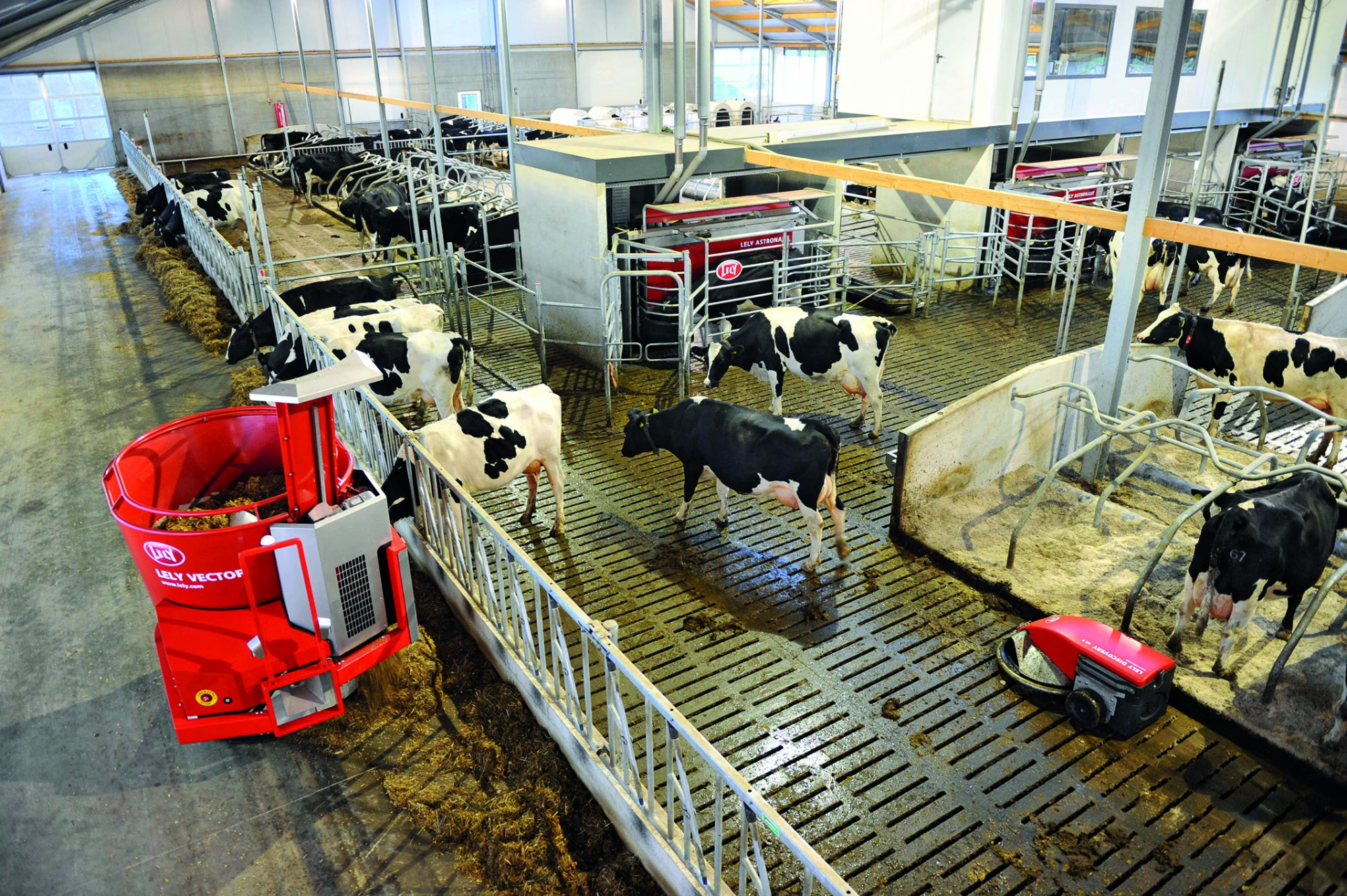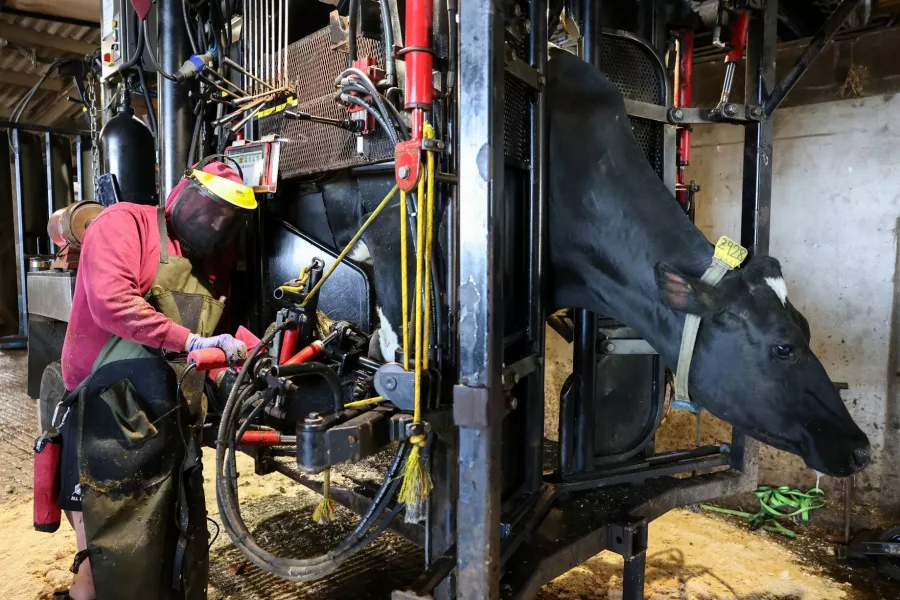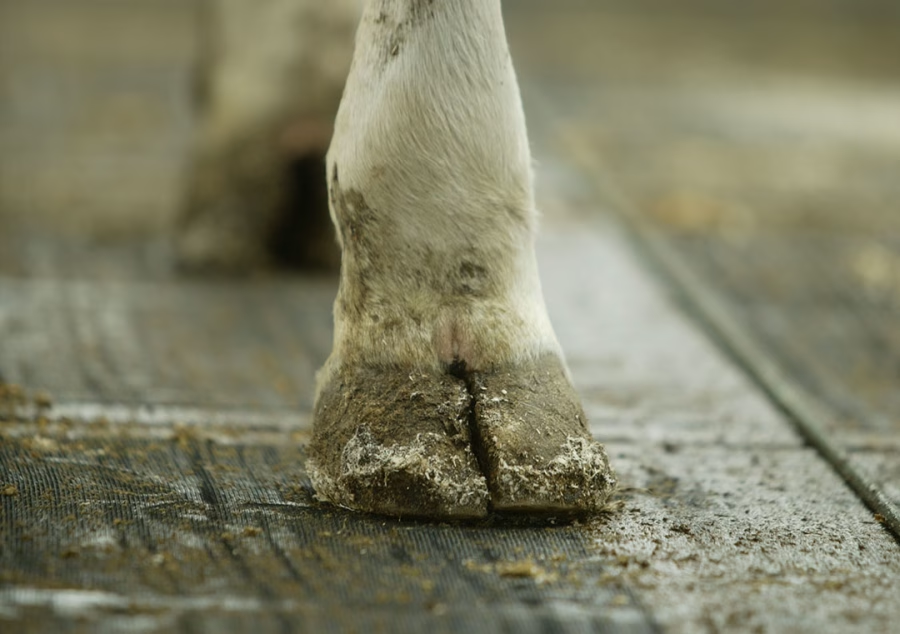Maximize cow comfort and productivity in robotic milking facilities. Learn how smart design and maintenance can prevent lameness and improve herd health. Curious how?

Imagine running a marathon with a sprained ankle. Your performance drops and your health is at risk. Dairy cows experience a similar scenario when they suffer from lameness. Their health and comfort directly impact milk yield, reproductive performance, and farm profitability. Lame cows face significant discomfort, affecting their ability to move, feed, and produce milk efficiently. Cow comfort is not just about animal welfare; it’s crucial for farm success. In robotic milking facilities, efficient handling space is essential to reduce lameness and ensure smooth operations. Investing in cow comfort is investing in your farm’s future. Healthy, comfortable cows are productive cows. Maintaining efficient handling spaces can reduce lameness, improve cow health, and boost productivity.
Recognizing the Impact of Lameness in Robotic Milking Systems
Understanding lameness begins with recognizing it as a condition marked by abnormal gait or stance due to pain or discomfort. It primarily affects the feet and legs of dairy cows. It can stem from poor flooring, inadequate hoof care, nutritional deficiencies, or infections like digital dermatitis and sole ulcers.
The implications of lameness are particularly severe in robotic milking systems. Unlike conventional parlor barns, robotic systems rely on cows’ voluntary movement to and from milking robots. Lame cows often hesitate to move freely, reducing milking frequency and decreasing milk yield, thus impacting overall herd productivity.
Additionally, robotic milking facilities are designed for continuous cow traffic. Lame cows can disrupt this flow, causing bottlenecks and requiring more labor for handling. Therefore, maintaining hoof health is crucial for cow welfare and optimizing farm operations.
The Value of Proactive Lameness Prevention
Preventing lameness is more cost-effective and beneficial than treating it after it occurs. Investing in proper barn design and maintenance during planning and construction can save costs and improve animal welfare in the long term. Key preventive measures include well-designed flooring, comfortable lying areas, and effective cooling systems.
Proper flooring is essential to prevent lameness. Grooved or textured concrete floors reduce the risk of slipping. Rubber flooring in high-traffic areas like transfer alleys can lower slippage risks and enhance cow comfort.
Ample, well-bedded lying areas encourage cows to rest instead of standing for long periods. Dry, clean resting areas with soft bedding materials like sand or straw are crucial. Regular maintenance ensures a comfortable environment.
During hot weather, cooling systems like fans and sprinklers help reduce heat stress, preventing excessive standing. Adequate ventilation keeps the barn environment comfortable, reducing the risks of lameness related to prolonged standing.
Proper Flooring: Crucial for Preventing Lameness and Ensuring Cow Comfort
Proper flooring in robotic milking facilities prevents lameness and ensures cow comfort. The type of flooring affects the cows’ health and milking frequency, directly impacting productivity.
Grooved or textured concrete floors minimize slips and fall, offering better traction and reducing injuries. The grooves should intersect to create a consistent, non-slip surface in all directions. High-traffic areas like transfer alleys, mil area rubber, and king flooring are highly beneficial. They provide a softer surface, reducing the impact on hooves and joints and enhancing comfort. Rubber floors also offer excellent grip, lowering the risk of slipping and falling.
Investing in tailored flooring solutions supports a safer environment and boosts operational efficiency. By reducing the risks of poor flooring, dairy farmers can improve herd welfare and ensure smooth traffic to and from milking robots.
Creating Restful Environments: The Importance of Well-Bedded Lying Areas
To ensure optimal cow welfare and productivity, providing well-bedded lying areas that encourage cows to rest rather than stand for prolonged periods is crucial. Comfortable resting spaces significantly reduce lameness risk by alleviating pressure on the hooves. Dry, clean, and soft bedding materials, such as sand or straw, are ideal as they offer necessary support and cushioning. Ensuring these materials remain uncontaminated by moisture or waste prevents infections and other health issues that could worsen lameness.
Regular maintenance of the lying areas is crucial for sustaining cow comfort. This includes frequent cleaning and replenishment of bedding materials to maintain their integrity. Farmers can create a stress-free habitat that promotes cow comfort and enhances overall herd health and productivity by prioritizing routine upkeep.
Cooling Systems: A Vital Asset in Combatting Heat Stress and Lameness
Cooling systems are vital for the well-being of dairy cows, significantly reducing heat stress, which can lead to lameness. Maintaining an optimal barn environment ensures cows stay comfortable and productive. Heat stress causes cows to stand for long periods, increasing hoof pressure and the risk of lameness. Efficient cooling systems are crucial.
Fans: Fans promote air circulation, dissipate heat, and keep the barn cool. Strategically placed fans reduce ambient temperature and provide relief to cows. Continuous airflow helps minimize moisture buildup, reducing hoof disease risks.
Sprinklers: Sprinklers directly impact cows by evaporative cooling. Combined with fans, they effectively lower cows’ body temperature, providing immediate heat relief. Regular water bursts mitigate prolonged high-temperature exposure risks.
Ventilation Systems: Proper ventilation maintains air quality and temperature. Effective systems remove hot, humid air and bring fresh air, creating a balanced environment. Designed to adapt to weather changes, they ensure consistent airflow and temperature control year-round.
Integrating fans, sprinklers, and ventilation systems reduces heat stress, prevents lameness, and enhances cow welfare. These systems work together to create a comfortable barn environment, supporting herd health and productivity, which is crucial for the success of robotic milking facilities.
Efficiently Designed Handling Chute Areas: A Cornerstone of Hoof Health in Robotic Milking Systems
Efficient handling of chute areas is essential for hoof health in robotic milking facilities. Dedicated hoof-trimming spaces ensure timely interventions, preventing minor issues from becoming severe. These areas need good lighting for visibility and adequate traction to prevent slipping, ensuring safe and efficient cow movement. Planning cow handling routes with their instincts in mind reduces stress for both cows and handlers. Placing handling areas beside robot fetch pens allows one person to manage tasks efficiently, improving cow welfare and streamlining operations in robotic milking facilities.
Weighing the Options: Centralized vs. Decentralized Hoof Trimming in Large Facilities
In extensive facilities, the design challenge lies in choosing between a single dedicated hoof trimming area for all pens or multiple trim areas within each pen. Centralized trimming areas can streamline resource management but may require cows to move longer distances, adding stress and inefficiency. Conversely, multiple trim regions close to each pen ease access, allowing regular, stress-free hoof maintenance without significant cow movement. This decentralized approach promotes a calmer environment and quicker interventions. Ultimately, the choice depends on the farm’s management practices and workforce structure to ensure efficient and regular hoof care to enhance herd well-being and productivity.
The Ideal Setup for Contracted Hoof Trimmers
The ideal setup for contracted hoof trimmers involves designing transfer lanes between barns to maximize efficiency and minimize cow stress. Transfer lanes should be wide enough for easy cow movement but narrow enough for controlled handling. They must include access to utilities like electricity for hydraulic chutes and high-powered wash hoses, ensuring smooth operations.
A Bud Box system is particularly beneficial as it uses the cows’ natural behavior to guide them into the chute with minimal resistance, reducing anxiety and streamlining the trimming process.
Hydraulic chutes with automated features further reduce stress by providing a reliable handling process with better restraint options for safer and more comfortable hoof trimming. Access to electricity ensures the efficient functioning of hydraulic systems, while high-powered wash hoses facilitate quick equipment cleaning, promoting a hygienic operation.
Positioning this setup at the far end of the barn, away from the robotic milking robots, minimizes disruption to milking activities and reduces herd stress. This thoughtful layout optimizes the hoof-trimming process and enhances cow welfare and operational efficiency in the robotic milking facility.
Strategic Footbath Placement: Enhancing Hoof Health in Robotic Milking Systems
Footbaths are crucial for maintaining hoof health and preventing diseases like digital dermatitis. They enhance cow comfort and productivity by promoting hygiene in environments where manure and moisture are prevalent. Proper footbath placement and design are essential for their effectiveness. Ideally, the footbath should be part of the robot exit pathway, allowing cows to walk through it naturally after milking, thus avoiding disruptions in cow traffic.
Footbaths must be long enough to ensure that each hoof is fully submerged for thorough cleaning and treatment. Regular replenishment of the solution and cleaning of the bath are critical to prevent contamination. Alternatively, placing the footbath at the end of the barn can work, although this may pose challenges as cows in robotic systems are not used to moving as a herd.
Regular maintenance and strategic accessibility are vital. Footbaths should be easy to approach and align with the natural movement of cows within the facility. This thoughtful placement helps maintain a smooth operational environment and reduces the risk of lameness due to poor hoof health.
Strategic Maintenance: Essential for Effective Footbath Functionality and Cow Traffic Flow
Maintaining footbaths is crucial for effective hoof disease prevention. Regular cleaning and replenishing the solution are essential, as dirt and debris reduce the solution’s efficacy. Consistent maintenance ensures footbaths remain effective in safeguarding hoof health. Strategically placing footbaths is also vital to minimize disruptions in cow movement. Ideally, footbaths should be part of the robot exit path, allowing cows to pass through naturally as they leave the milking station. This placement leverages existing traffic flows, reduces reluctance, and ensures a smooth transition, maintaining an efficient cow traffic system within the robotic milking facility.
The Bottom Line
Ensuring efficient handling space in robotic milking facilities reduces lameness and boosts herd health and productivity. Strategic barn design, consistent maintenance, and advanced technologies are essential. Well-designed flooring like grooved concrete or rubber reduces slips. Comfortable, well-bedded lying areas alleviate hoof pressure. Effective cooling systems combat heat stress, encouraging natural cow behavior and reducing lameness. Handling chute areas should prioritize ease and safety for efficient hoof care. Whether to have centralized or decentralized hoof trimming depends on facility size and management preferences. Well-placed footbaths are essential to prevent hoof diseases without disrupting cow traffic. The bottom line is investment in design, regular maintenance, and leveraging cutting-edge technologies. These measures ensure cow health, boost productivity, and enhance farm profitability. As the dairy industry evolves, adopting these best practices is crucial. Partnering with knowledgeable professionals and committing to cow welfare will help farmers thrive.
Key Takeaways:
- Proper flooring: Implement grooved or textured flooring and rubber mats in high-traffic areas to minimize slips and falls.
- Comfortable lying areas: Provide well-bedded, dry, and clean resting spaces to encourage cows to lie down rather than stand for long periods.
- Effective cooling systems: Use fans and sprinklers to reduce heat stress and prevent prolonged standing due to excessive heat.
- Dedicated hoof-trimming areas: Design special areas for hoof care to ensure easy and safe handling, reducing stress and improving efficiency.
- Well-organized footbaths: Strategically place footbaths to maintain hoof health without disrupting cow traffic to milking robots.
- Regular maintenance: Ensure that all aspects of the facility, from footbaths to lying areas, are routinely maintained for optimal function and cow comfort.
Summary:
Lameness is a major issue affecting dairy cows’ health and productivity, affecting milk yield, reproductive performance, and farm profitability. It can be caused by poor flooring, inadequate hoof care, nutritional deficiencies, or infections like digital dermatitis and sole ulcers. In robotic milking facilities, lame cows often hesitate to move freely, reducing milking frequency and milk yield. To prevent lameness, proper barn design and maintenance are crucial. Key preventive measures include well-designed flooring, comfortable lying areas, and effective cooling systems. Regular maintenance of lying areas is essential for cow comfort. Efficient cooling systems, such as fans, sprinklers, and ventilation systems, support herd health and productivity. Dedicated hoof-trimming spaces ensure timely interventions and reduce stress for both cows and handlers. Strategic footbath placement is also essential for hoof health and preventing diseases like digital dermatitis. Partnering with knowledgeable professionals and committing to cow welfare will help farmers thrive in the evolving dairy industry.














